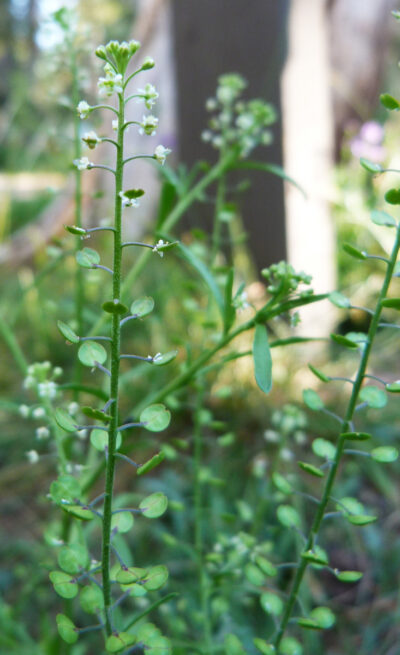
Field mustard (Brassica rapa) on a Preservation Trust preserve on San Juan Island | Staff archive
We recently received a question from an astute social-media follower about why we use a non-native plant species (field mustard, or Brassica rapa) in habitat-expansion patches for the Island Marble Butterfly, when another member of the brassica family that is native to our region (Lepidium virginicum, aka Menzies’ pepperweed) was present in the butterfly’s historic habitat.
It’s a great question, and we thought we’d share some thoughts on the topic.
The endangered Island Marble Butterfly (Euchloe ausonides insulanus), which today survives only in coastal prairie areas in and around what’s now known as American Camp on San Juan Island, evolved in a historic habitat that has diminished and changed over time—the main reason for the species’ decline and precarious hold on existence.

Lepidium virginicum var. menziesii | Al Keuter/CalPhotos
Though the native Lepidium virginicum grew in the dry, gravelly soils of the historic prairies, these landscapes have been greatly altered since European occupation. Grazing, invasive plant introductions, and increasing storm surges that push beaches farther inland have all played a role. Lepidium can’t compete well with the non-native, invasive pasture grasses that have colonized most of the grasslands on San Juan Island. Where Lepidium exists today on dune and upland beach areas, Island Marble Butterflies are still using it as a host plant, but most of the designated critical habitat area (established as part of the species recovery plan) includes prairie/pasturelands. There, it has proven more successful to plant the non-native field mustard, which can hold its own against other non-native plants. And, fortunately, the IMB has readily adapted to Brassica rapa as the host plant on which females lay their eggs and larvae feed as they develop.
We strive to take these kinds of changes in stride and remind people about the adaptability of a species that can completely switch to a new host plant. Instead of drawing lines in the sand (as we do when we make the assertion that “native = good, and non-native = bad”), we may need to shift our thinking. If this extremely rare butterfly is telling us that an introduced plant is satisfying its needs, then maybe we should follow its lead. The butterflies are making a choice that goes beyond the human constructs we put around the terms “native” and “non-native.”
Brassica rapa has been in the islands for more than 150 years now and fits into the landscape in a relatively non-invasive manner. How long does a species exist on a landscape before it is considered native? What other factors ought to be considered? We offer no absolute answers, but invite more conversation and questions like these, which we think about and discuss (endlessly!) as we form our plans for helping to manage and preserve life across the archipelago.
